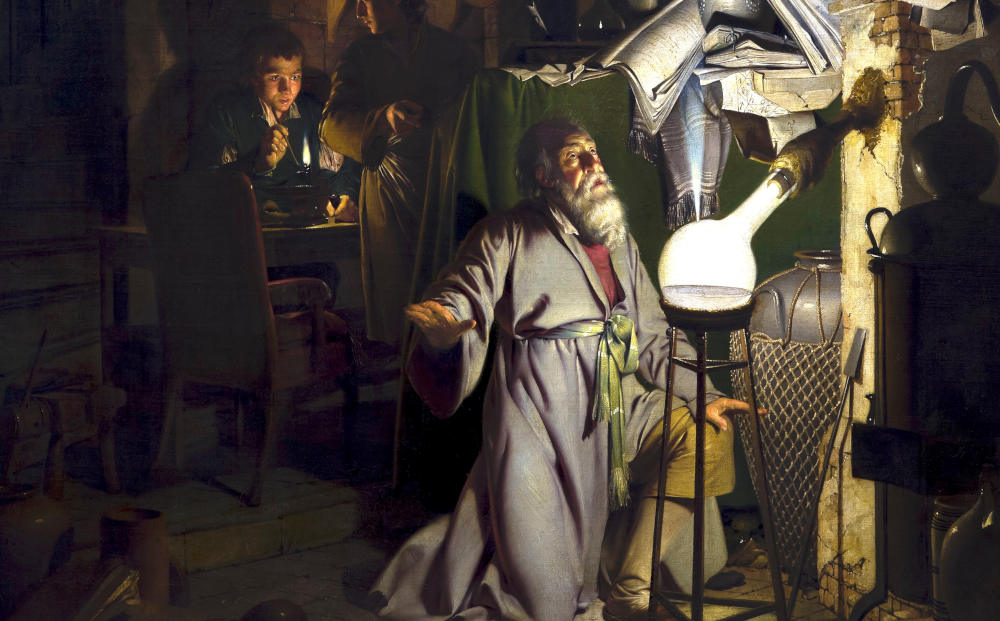Table of Contents:[hide]
Delving into the Enigmatic Depths of "The Alchemist Discovering Phosphorus" by Joseph Wright of Derby Full Video
A Journey into the Realm of Science, Alchemy, and the Unknown
Joseph Wright of Derby's captivating masterpiece, "The Alchemist Discovering Phosphorus," stands as a remarkable testament to the artist's genius, his ability to evoke complex emotions, and his profound exploration of scientific inquiry. Its enigmatic subject matter, striking imagery, and masterful use of light and shadow have captivated and perplexed viewers for centuries, igniting countless interpretations that continue to enrich our understanding of art, science, and the human condition.
Unveiling the Narrative and Symbolism
The painting's full title, "The Alchymist, in Search of the Philosopher's Stone, Discovers Phosphorus, and prays for the successful Conclusion of his operation, as was the custom of the Ancient Chymical Astrologers," unveils a rich tapestry of narrative and symbolism that invites us into the depths of the artist's intentions. The scene unfolds within a dimly lit chamber, where an alchemist, his figure bathed in the ethereal glow emanating from a vessel, kneels in reverence and anticipation. The alchemist's surroundings, a medieval stone room with gothic arches and high, pointed windows, further enhance the painting's mystical atmosphere, transporting the viewer to a time when alchemy was a blend of scientific inquiry and mystical beliefs.
Exploring the Enigma of Phosphorus Discovery
One of the painting's most intriguing aspects lies in the question of whether it directly depicts the actual discovery of phosphorus by Hennig Brandt in 1669. This widely circulated story was known to Wright through his friend James Keir, a translator of chemical texts. While some art historians believe the painting directly portrays Brandt's discovery, others suggest a more profound and symbolic interpretation. The choice of a medieval setting and the alchemist's prayerful posture hint at a deeper exploration of the relationship between science, alchemy, and religious practices, suggesting that Wright was not merely recreating a historical event but rather delving into the philosophical and spiritual dimensions of scientific discovery.
The Alchemist's Instruments and the Dialogue with Modern Science
Despite the painting's medieval setting and its connection to alchemy, Wright meticulously depicts alchemical instruments and books that reflect the serious study of chemistry. These tools, reminiscent of those used by Wright's contemporary chemists, suggest a dialogue with modern scientific practices. This juxtaposition of the old and the new, the mystical and the rational, further enhances the painting's complexity and invites viewers to contemplate the evolution of scientific thought, highlighting the transition from the mystical approaches of alchemy to the more empirical methods of modern science.
Challenging the Enlightenment's Rational Worldview
While the painting seems to nod towards the rational world of science, it ultimately challenges the prevailing Enlightenment notion of a purely rational and explicable universe. The alchemist's kneeling posture before the inexplicable light, a source of both wonder and fear, symbolizes humanity's enduring fascination with the unknown and the mysteries that lie beyond the realm of pure reason. The painting reminds us that scientific discovery is not always a linear process and that intuition, wonder, and the inexplicable play a significant role in our pursuit of knowledge. It challenges viewers to confront the limitations of rational thought and to embrace the role of serendipity and the unexpected in the process of scientific discovery.
FAQ
1. What is the painting "The Alchemist Discovering Phosphorus" about?
The painting depicts an alchemist kneeling in a dimly lit chamber, his face illuminated by the radiant glow emanating from a vessel. The alchemist's hands are clasped in prayer, his expression a blend of awe, reverence, and anticipation. The alchemist's surroundings, a medieval stone room with gothic arches and high, pointed windows, further enhance the painting's mystical atmosphere.
2. Who is the alchemist in the painting?
The alchemist in the painting is not meant to be a specific historical figure. Instead, he represents the archetype of the alchemist, a seeker of knowledge who is willing to experiment and explore the unknown.
3. What is the significance of the phosphorus in the painting?
Phosphorus was a newly discovered element in the 18th century, and its discovery was seen as a major breakthrough in chemistry. The alchemist's discovery of phosphorus in the painting symbolizes the power of human inquiry and the potential for scientific progress.
4. What is the meaning of the painting's title?
The full title of the painting is "The Alchymist, in Search of the Philosopher's Stone, Discovers Phosphorus, and prays for the successful Conclusion of his operation, as was the custom of the Ancient Chymical Astrologers." This title suggests that the painting is about more than just the discovery of phosphorus. It is also about the alchemist's search for the philosopher's stone, a legendary substance that was said to be able to turn base metals into gold.
5. What is the significance of the painting's setting?
The painting's setting in a medieval stone room is significant because it suggests that the alchemist's work is rooted in the past. This is in contrast to the rational and empirical methods of modern science. However, the painting also includes some elements of modernity, such as the alchemist's use of scientific instruments. This suggests that Wright was interested in the relationship between traditional and modern ways of knowing.
6. What is the overall message of the painting?
The overall message of the painting is that scientific discovery is a complex and multifaceted process. It is not always a linear process of experimentation and observation. Instead, it can also involve intuition, luck, and even a touch of mysticism. The painting also suggests that the pursuit of knowledge is a lifelong journey that is full of both wonder and uncertainty.


